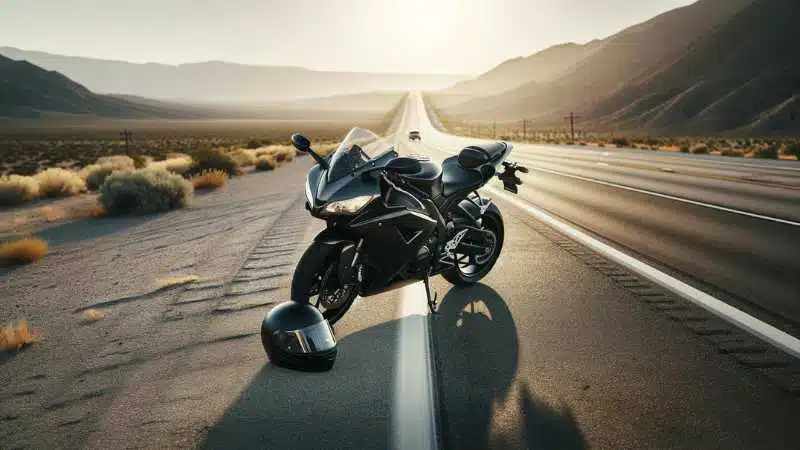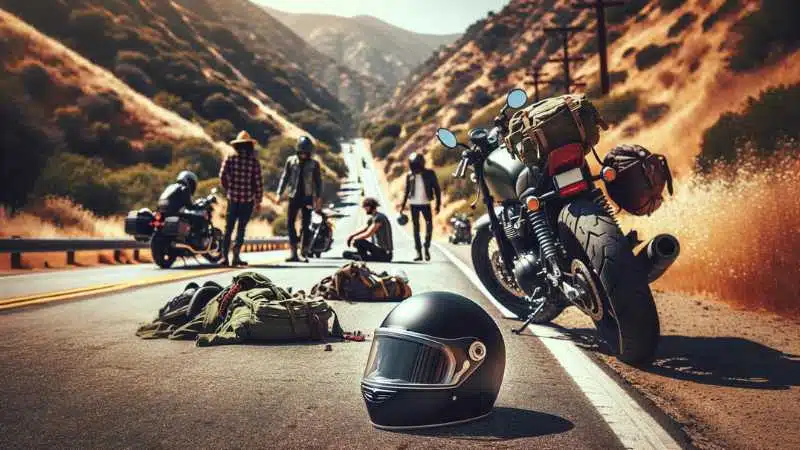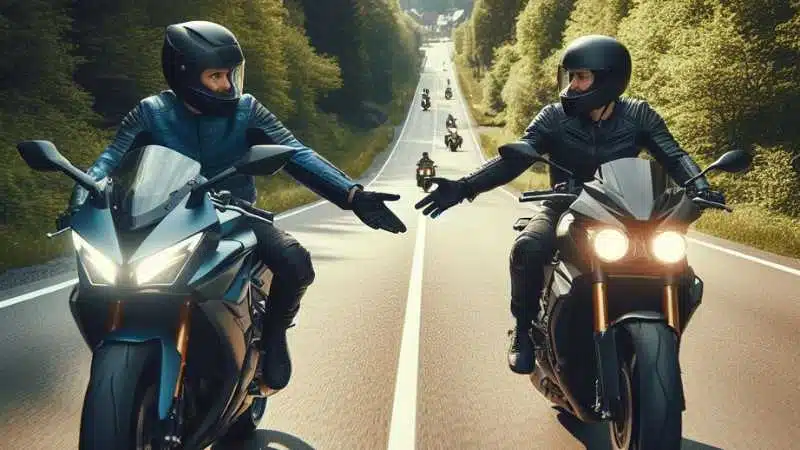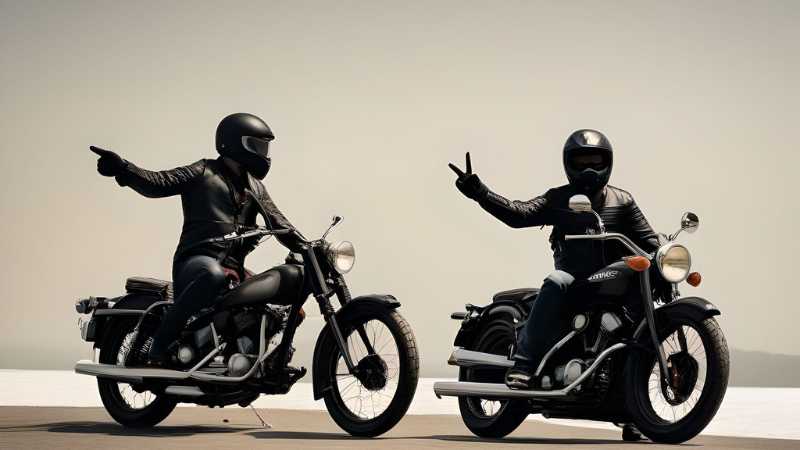Adaptation is what has brought man this far. Voiceless communication becomes the go-to when the roar of engines drowns out verbal communication. So, look out for signs and signals from fellow riders while navigating the chaos of highways.
One of these signals is the helmet behind a motorcycle. It may mean the rider has faced some mechanical issue or sustained an injury. It is a distress signal meant to capture the attention of others. A helmet behind a motorcycle may also be a token of respect for a deceased person or a symbol of a community, representing freedom and exhilaration.
Here’s a detailed read on how to interpret this particular sign and what the helmet behind motorcycle meaning suggests in different contexts.
Table of Contents
- 1 What does a helmet behind a motorcycle mean?
- 2 How effective is the helmet behind a motorcycle distress signal?
- 3 Basic etiquette associated with placing helmet behind bike
- 4 Other Common Motorcycle Distress Signals
- 5 Essential things you can do to prevent distressing situations as a motorcyclist
- 6 FAQs
- 7 Conclusion
What does a helmet behind a motorcycle mean?
The helmet, a fundamental component of road safety for bikers, can be positioned in various ways to convey messages. The helmet can be placed on the ground behind the bike or behind but not on the ground. It may sometimes be placed near the front tires, too. Occasionally, you may even find a helmet sitting along the roadside with no motorcycle in sight. All of these are interpreted differently.
The first is, more often than not, a distress signal, especially if the helmet is placed a bit farther (about 10 to 12 feet) from the bike in an unconventional, odd manner that asks for passersby’s attention.
The latter two usually mean there is no emergency assistance needed. I’ll describe what they represent later in the article. Let’s start with potential reasons for this helmet distress signal.

Mechanical Issues:
First and foremost are mechanical issues. Among all the reasons you may find a helmet behind a bike, this one is the most common. The rider could have faced some mechanical issues with the bike, including flat tires, a broken chain, etc.
If you find someone with such a problem, see if you have the tools and expertise to solve it. Either that, or you can link them up with a mechanic.
Fuel Shortage:
Another meaning of the helmet behind the motorcycle on the ground may be that the rider has run out of fuel and is now awaiting help. You should always pre-check, but stuff happens, and fuel gauges are well-optimized.
You can carry a small, mountable fuel bottle to handle such a situation. They can act as your reserve, and if you find someone stranded, you can lend a bit more than a thumbs-up. Also, if you’re an amateur, never trust the fuel gauge. It will do you dirty.
Navigation:
The helmet can be placed behind the motorcycle if someone has trouble navigating.
Weather Extremes:
Although it is advisable to check the weather conditions before motorcycle riding, the weather can be surprising. Motorcyclists don’t have the same protection as car riders, and long highways can become a curse if the weather gets out of hand.
It’s better to find a shelter and wait for it to subside. Placing your helmet behind the motorcycle and then retreating to a shelter (where you can watch your motorcycle and events on the road) can keep you safe and alert other riders.
Community Identification:
Now, this is mostly a distress signal for the helmet behind the motorcycle but not on the ground. In most cases, this may represent solidarity with the biker community, a symbol of appreciation and respect for motorcycle safety gear, and the biker brotherhood that prevails in the motorcycle culture.

You may find the helmet embellished with stickers to represent all the open roads the bike has traversed. The helmet may be there to honor a fallen rider, represent the adventures of a retired rider, or be a tribute to riders injured in an accident. However, don’t rule out the possibility of the rider being in trouble, emphasizing the importance of motorcycle safety advocacy.
If you find such a motorcycle parked on the side, assess the situation. Does the rider look in distress? Are there any other distress signals being given out? Then act accordingly, respecting the riding traditions and camaraderie within the motorcycle community.
A white helmet on the ground means:
It may be a headstone. Yes, you read it right. A white helmet, motorcycle, or bicycle represents the crash site of a rider. These are called “ghost helmets for bikes.” You can identify them by their placement; usually, you’ll find them surrounded by other decorative items.
This means that the rider in distress is beyond help now. You can admire, reflect, and drive on. They are a stark reminder that the untamed spirit and boundless joy woven with open roads can also have a deadly face that one should not forget about.

Health Emergencies:
If you get injured and are unable to call an ambulance or sort, then use this sign of distress and keep in sight to get help as soon as possible. Use your body language, too, to get help quicker.
The National Highway Traffic Safety Administration (NHTSA) also advises motorcyclists to wear bright clothes on the road to be more conspicuous. This brings us to the question: realistically, how effective is this distress signal?
How effective is the helmet behind a motorcycle distress signal?
Being prepared for the worst is not just good practice; it’s a cornerstone of rider safety in motorcycling. However, life isn’t as smooth a ride, so international distress signal recognition is essential. You may have to recognize it to help someone or get help yourself.
The helmet behind the motorcycle is not a universal sign, although many like to regard it as one. Being a part of the signs a few riders came up with for effective communication back in the 2000s, many would be aware of it, but not all.
Regardless, with an odd helmet placement like this, you’re bound to attract the attention of others. You can use this attraction to communicate further or pair it up with other distress signals, thereby increasing the overall safety awareness within the motorcycling community.
But make sure you look in distress.
I don’t mean you start flailing and wailing-nothing against it; if it’s desperate times calling for desperate measures, you’re free to do that too- but try not to look like you’re just a rider taking a break from a long journey either.
Basic etiquette associated with placing helmet behind bike
Understanding the basic etiquette of motorcycle distress communication is not only a testament to the unity among motorcyclists but also reflects a strong commitment to motorcycle safety.
Pick it up again:
First comes responsibility. After the distress signal has served its purpose or assistance has been received, pick up the helmet immediately. Otherwise, it may concern other people in vain.
Don't Misuse:
Placing a helmet on the ground for purposes such as reserving parking spaces can compromise the effectiveness of the gesture. Utilizing it judiciously ensures that the signal retains its significance.

Stop for Others:
In the spirit of camaraderie prevalent among bikers, you do a solid job getting one. Whether offering assistance or simply checking in, the gesture strengthens the bonds within the motorcycle fraternity.
Do not move someone else's helmet or ride:
Each helmet placement carries a unique meaning, and altering it can, in the worst case, offend a community quite a bit.
If you’re distressed, watch if it’s an unknown or unsafe territory. General riding camaraderie aside, some people might grab your stuff and run for it. You don’t want to be left not only stranded but also empty-handed.
Other Common Motorcycle Distress Signals
Apart from the helmet behind the motorcycle, several other non-verbal cues can successfully convey urgency, including:
The thumbs down:
Very simple yet very effective. If a passing driver gives you a thumbs up, respond with a thumbs down if you’re in a predicament or a thumbs up if you’re okay.
Flashing lights:
A rapid succession of flashes, one of the critical emergency signals, can signify an emergency situation on the road. Motorcycles also have emergency yellow lights, which signal a crisis.

Signal whistles or flashes:
This approach significantly enhances the chances of being noticed when visibility is compromised, a crucial factor in reducing the risk of motorcycle accidents.
Flipping over the bike:
A flipped bike is seldom a good sign. And your fellow riders will pick up on it quite quickly as well. It can serve as an unmistakable sign of distress.
Smoke signals and flares:
If you’re traveling through a remote area, these visual markers cut through the visual clutter and can grab attention just fine.
Horn:
A continuous or patterned use of the horn is a classic distress signal.
Hand signals:
Hand signals are widely used in the motorcycle community and convey various messages. Specific gestures can indicate a need for help, point out hazards, or signal an upcoming stop.
It would help to familiarize yourself with the motorcycle group signals used in a particular region. For example, two fingers pointing towards the ground is a popular token of gratitude (thank Harley and Davidson for it).
Essential things you can do to prevent distressing situations as a motorcyclist
Proactive measures play a pivotal role in decreasing an otherwise distressing situation. The stuff you can carry on a motorcycle is limited as it is.
But before you take out your ride, examine tire pressure and tread depth, assuring optimal traction and stability. Inspect and verify the functionality of hand and foot brakes, headlights, and signal indicators.

Don’t forget the fluid levels, including oil and brake fluid. Still better, get a compact toolkit for on-the-go maintenance, encompassing tire pressure gauges, brake fluid testers, and essential hand tools.
Stow a spare headlight bulb, portable air compressors, and a small bottle of brake fluids, and you get the gist. Bad times don’t play trumpet, and this can help a ton.
FAQs
What does tapping your motorcycle helmet mean?
The helmet tapping signal is a warning commonly used to alert fellow riders about police presence or road hazards for motorcycles.
What does it mean when a biker sticks his leg out?
Sticking a leg out can indicate a turn or a gesture of thanks to another rider. A bit weird, but these work well out there.
Is it bad luck to put your helmet on the ground?
Helmets on the ground can be many things. Bad luck isn’t one of them. Even if your helmet fell on the ground, the EPS (inner impact-absorbing part) would remain intact, so the helmet would remain functional.
What does it mean if the helmet is on the ground beside the motorcycle?
Placement beside the bike signifies distress, possibly due to mechanical issues, injury, or a plea for roadside assistance. If you find a helmet besides a motorcycle, stop by to check if the rider is okay. However, no one’s in distress in the parking lot, and it’s probably there on the ground to avoid a fall.
How do we know if the biker is in distress?
Distinct distress signals, like a helmet behind a motorcycle or unusual gestures, indicate a rider is in need. Assess the situation and offer help accordingly.
Conclusion
A helmet behind a motorcycle means that the rider might be in distress. If the helmet is on the ground, look for the rider and check to see if something’s wrong. However, if you find a lone helmet next to a bike on the ground, surrounded by decorations, it is often a poignant symbol, with the helmet serving as a fallen rider’s commemoration.
A helmet placed behind the motorcycle but not on the ground may also be present there as a reminder of a passing rider. Typically, the symbol conjures up images of a neighborhood bound together by an unspoken brotherhood. On the open roads, riders look out for each other and nurture this unique bond of humanity.

